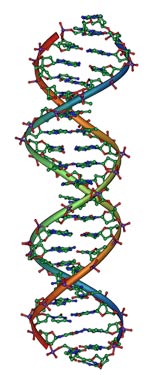Flexibility trumps fitness in sexual reproduction
So says a new theory in evolutionary biology, which emphasizes genes that play well with others
| 03 December 2008
 Christos Papadimitriou
Christos PapadimitriouBERKELEY — The utility of sex, according to an intriguing new theory of evolutionary biology, may reside in its ability to promote genes that play well with many other partners rather than those that shine with just one specific set of genes.
This idea of genetic mixability, described in the journal Proceedings of the National Academy of Sciences the week of Nov. 24, hits on the difficulty evolutionary biologists have had in understanding sex, specifically its role in population genetics and Darwin's survival-of-the-fittest mantra.
"It's the generalist winning over the specialist," says Christos Papadimitriou, C. Lester Hogan Professor of Electri-cal Engineering and Computer Sciences at Berkeley and co-author of the paper.
"During the past century, it has often been assumed that sexual reproduction should somehow facilitate the increase in fitness under natural selection, leading to the 'best' combinations of genes," says lead author Adi Livnat, a Miller Institute postdoctoral fellow working in the Department of Electrical Engineering and Computer Sciences. "But no agreement has been reached on whether and how this could really work. One might think, for example, that by bringing together genes from different individuals, sexual reproduction could create a very successful combination of genes. But just as sexual reproduction will create that successful combination, it could also break it down in the next generation."
That sex can actually impede the increase in the fitness of the population raises the question of how it can remain the dominant form of reproduction across all manner of species. Sex — at its core the merging of genes from different individuals to create genetically unique offspring — is the reproductive method of choice among humans, plants, and many fungi. This form of reproduction must be doing something right in terms of evolution.
 Veering from the assumption that sexual reproduction increases the average fitness of a population, the researchers came up with a new measure they call "mixability" to represent a gene's ability to perform well across many different combinations. They tested the mixability measure in a number of scenarios within a well-established population-genetic framework.
Veering from the assumption that sexual reproduction increases the average fitness of a population, the researchers came up with a new measure they call "mixability" to represent a gene's ability to perform well across many different combinations. They tested the mixability measure in a number of scenarios within a well-established population-genetic framework.
They found that if the goal is to maximize fitness by finding a particularly good combination of genes, asexual reproduction — which increases a population's numbers at a much faster rate than sexual reproduction — works very well.
In contrast, sexual reproduction, through the process of recombination and segregation of chromosomes, strongly favors genes that work well in many different variations rather than any one good combination. In that view, the authors wrote, alleles of the same gene compete with each other based upon how well they perform on average rather than how well they perform in any one specific combination.
"It's important to note that during the process of evolution the mixability value increases, though it doesn't increase all the time," says the paper's co-author Marcus Feldman, professor of biology at Stanford University and a world-renowned theorist in evolutionary biology. "The approach we take is different from usual because we're interested in evolutionary transience, and in the long run our mixability value may actually decrease because too much variability is lost from the population."
Even so, sexual reproduction has a great advantage for mixability compared with asexual reproduction, according to the models in the paper.
In what may appear at first to be an unconventional comparison, sexual reproduction has something in common with the rebalancing of a stock portfolio at regular intervals, explained Livnat.
"If every year some money is taken out from stocks that have performed well and reallocated to stocks that lost money, the growth rate of the portfolio is averaged out over time," he says. "Analogously, sexual reproduction entails moving genes from one combination to another in a manner that, over the course of multiple generations, can tie the success of a gene to its average performance across genotypes rather than its maximum performance."
Livnat started thinking about this problem in discussions with Papadimitriou, a leading computer theorist whose research includes optimization algorithms. Such programs are widely used to find best outcomes in applications such as computer networks, transportation planning, and financial models.
The researchers explained that, of the two main techniques for optimization programming, one, known as simulated annealing, solves problems using a process analogous to asexual reproduction, while the other, known as genetic algorithms, is inspired by sexual reproduction. Genetic algorithms should theoretically be the better of the two techniques at finding the best solutions for a problem because they mimic an approach that is so dominant in nature. However, as it turns out, genetic algorithms often perform no better than simulated annealing.
"We were trying to figure out why an algorithm that mimics a good idea in nature was not coming up with better results," says Papadimitriou. "It dawned on us that what sexual reproduction is doing is not maximizing fitness but doing something more subtle. It is bringing about genetic variants that perform well across many possibilities in connection with a great variety of genetic partners. If a particular gene variant can do well with many other alleles, not just a highly specialized variant, evolution is advanced."
The researchers noted that when the human genome was sequenced in 2003, there was some surprise that humans did not possess far more genes than other species. It turns out that how those genes are combined may be a critical factor in distinguishing humans from other species, supporting the importance of flexibility over fitness.
Feldman, who has studied the evolution of sex and recombination for more than three decades, says he expects this new theory to trigger much debate among his peers. "This problem of understanding sex will go on being one of the central issues in evolution," he says.

